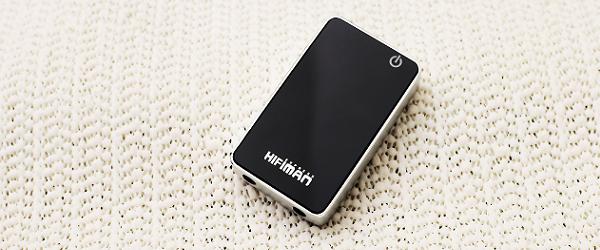In a world filled with ebony boxes churning out tunes in all sorts of forms and fashion, very few are able to mix form and function in such a small and affordable package like Head-Direct. Released under the HiFiMAN Express brand, the HM-101 is Head-Direct’s newest release in the portable USB Sound Card, or DAC, arena. No bigger than a Smint dispenser, the HM-101 is a no-frills, plug-and-play digital-to-analog converter that, in a nutshell, takes over the work of your computer’s stock sound card.
All you have to do is plug one end of the cable into the HM-101, and the other into your USB port, wait a few seconds, plug in your headphones, and begin listening to better-sounding music. The simplicity of using the HM-101 is largely rooted in the straightforward HiFiMAN design and the choice of parts. A USB receiver, a DAC chip, and a class AB stereo headphone driver (in other words, a basic nonadjustable amplifier), are the only major parts housed within the HM-101.
Performing DAC duties is the (Japan) Burr-Brown PCM2702E, an entry-level chip providing excellent performance levels. Even several DIY DAC projects incorporate the PCM2702E in the design. The headphone driver is an NXP Semiconductors TDA1308 integrated class-AB stereo headphone driver that provides the most basic amplification without a physical volume control.

Frequency Response: 20 to 20k Hz
THD: 0.07% S/N: 96 dB
Stereo Crosstalk: 78 dB
Headphone Amplifier Output: 62 mw at 36 Ohm 26 mw at 150 Ohm
Dimension: 36 * 60.5 * 13.8 mm
DAC: Burr-Brown PCM2702E
AMP: NXP Semiconductors TDA1308 integrated class-AB stereo headphone driver
Plastic is the material of choice for the HM-101. But in no way is it clad in a boring monotone scheme–a sleek ebony with a thin clear coat adorns the front and back face, while the sides are covered in silver that’s made to look like brushed metal. It’s small enough to hide inside the palm of an adult’s hand. Upon connecting with a computer, the power indicator on the upper right of the device glows a deep blue hue. Connecting the HiFiMAN HM-101 requires a USB cable that has a Mini B jack on one end. HiFiMAN is kind enough to supply one with the HM-101. It takes less than a minute for the computer to identify and install the necessary drivers. You then choose between the two 3.5mm (1/8″) jacks. The left jack is for the analog line-out signal, while the right is the headphone jack. The HM-101 does not have any volume potentiometer, so volume is adjusted via the external volume control of your laptop/computer or from the media player software.
The $39 price tag seems to fit with the HM-101 especially if you look at its diminutive size, but when you actually get to listen to it, this assumption is easily thrown out the window. For nitpickers, it’s not dead silent nor is it hiss-free, and it has very poor RF shielding (don’t put your mobile phone beside it). But the improvement in quality it delivers compared to most commercial computers’ stock sound card is very obvious. The line out signal is clean and uncolored, which is perfect for the next logical step: external amplification from either a portable or desktop amp. Some mid-impedance headphones may even tap into the line out signal directly, though there is an obvious lack of general impact in the sound.
Using the headphone out jack on the HM-101 adds the much needed oomph in the sound, making it more musical and lifelike. Bass can be low when it needs to be, mids flow with presence and liquidity, and treble is not choked or rolled-off. Though not a tenfold increase in volume compared to the line out jack, this is more of a twofold one. And that is more than enough for most genres of music, even for online videos that play weak even when turned all the way up. Remember when using the HM-101’s headphone out for the first time, set the volume of your computer and media player to zero. The HM-101’s built-in amplifier (if you can call it one) is fixed at its optimum level and actually does a well enough job without introducing any noticeable distortion. What is noticeable, though, is that from most media players’ volume of zero, going to the next increment may already be too loud for low-volume listeners. Some computers have volume controls that steadily increase in small increments at 20-80%, then suddenly switch to larger ones in the 80-100% range.
For standard low-impedance headphones in quiet environments, the digital volume level can be set as low as 10% to sound comfortable. Even chamber pieces with a high dynamic range do not need to go beyond 35%. More demanding headphones with low sensitivity, high impedance, or both, may be better off being powered by an external amplifier and not the HM-101’s built in one. The Burr-Brown still proves to be a robust DAC though, being able to provide a standard 44/16 output without sounding too clinical or cloudy. The DAC chip itself costs as much as half of the entire thing. The HM-101 does not have any batteries, and is completely USB-powered. This makes the HM-101 a perfect companion to most netbook users who need a quality DAC with a small form factor but does not look like a toy. Or as a back-up DAC for the traveling audiophile. At this point, the $39 HM-101 makes a crystal clear statement: Quality can be found at a decent price, and not look half-bad in the process.




